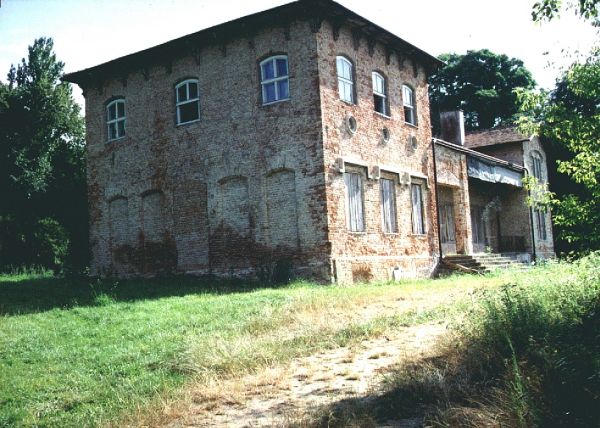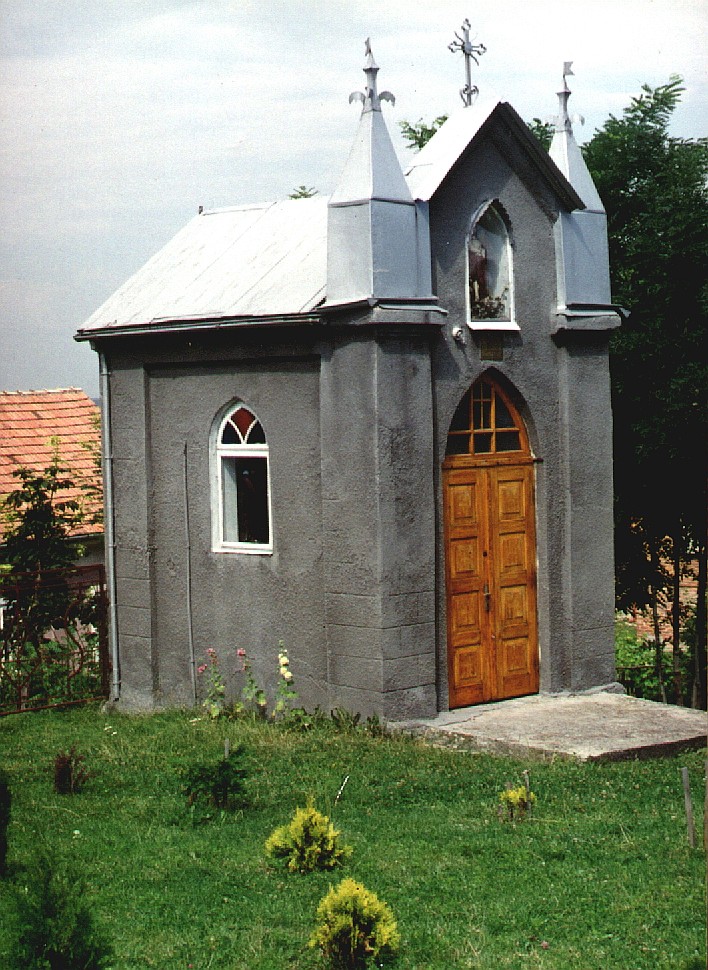Dąbrowa
The first reliable historical document that confirms the existence of our village is a registry called Świętopietrze Register written between 1325 and 1327. It lists parishes belonging to Dębica deanery including Dambrowa. The document was written in Latin.

Kapliczka Długoszów
In XV century a famous chronicler Jan Długosz mentions the parish in Trzciana consisting of two villages: Trzciana and Dąbrowa. The conclusion is that Trzciana was founded later than Dąbrowa. According to a legend, the first church in Dąbrowa was built in the place where nowadays the wayside shrine of the Długosz family is situated.
Jan Długosz also mentions a knight’s manor in Dąbrowa paying tithe to the parish priest in Trzciana. The first well-known owner of Dąbrowa was Jan Pakosławic from Stróżyska who lived in XV century.

Dwór w Dąbrowie
The elderly dwellers of Dąbrowa invoke ancient stories that say there once was a burgh in Dąbrowa. It protected the area and the borders of the Piasts’ country. It is traditionally believed to be situated in the same place where later the knights’ manor was built, and where nowadays there is a manor house. It is also believed that there was a parish church next to the burgh. Unfortunately it was probably destroyed by a fire or wars.
For centuries Dąbrowa often changed hands. Ecclesial documents from 1721 say that in Dabrowa there was a chapel made of bricks dedicated to St. Michael where holly mass was celebrated.
The last owners of the manor house in Dąbrowa were Romuald Woyciechowski and his sister Augusta Jędrzejewicz from the Woyciechowski family. After the World War II the manor house was crumbling. For some time there was a school and a kindergarten in the building. A few years later it was bought cheaply by the Jedrzejewicz family. Currently the park and buildings are being renovated.
The times of the last World War and the following years are well remembered by the oldest dwellers of Dąbrowa. Their memories were collected and recorded by the students of the sixth grade. On the grounds of the information they recaptured the most important events from the village history. Thanks to the memories of Mrs. Stefania Pająk we know that the name of the village comes from ‘dąbrowa’- the wild deciduous forests or scrubland where a lot of oak trees grew. Dąbrowa was first mentioned in the XIV century. There was a parish church here which was moved to Trzciana in 1416 by its owner Paweł. In 1987 Dąbrowa regained the parish. A year later in 1988 a piece of land was given over for a graveyard. The church was consecrated in 1985.

Kapliczka Św. Floriana
Before the war the houses were built of wood because of poverty. However, they were well-cared for. There were dirt roads not asphalt roads. Horse- drawn carriages were moving along those roads. Cars were a rare sight. Children studied at school where there were only five grades and three teachers. People were poor so even if a child was a very good student, they often had to give up school. There was only one shop with little goods in it. The fields were not set-aside. Each piece of ground was cultivated and crops were grown. People often worked for the owners of the manor house picking fruit or vegetables. In Dąbrowa there were no fruit trees like there are nowadays. Only the manor house had an orchard. There was not a health center in the village but one poorly-educated doctor. When people got seriously ill, they often died. During the war there was a tuberculosis epidemic.
In 1939 the World War II broke out. People were forced to give almost everything to the Germans and they often had nothing to eat. Some people of Dąbrowa emigrated to the West. The Germans often caught people on roads and took them away to labor camps.

Kapliczka Matki Bożej Różańcowej
After the war Dąbrowa started to grow. However, some people who devoted themselves to the development of their village were forced to join the Socialist Party and encouraged to destroy crosses. A new asphalt road was built and in 1974 the first PKS bus appeared. In 1979 the people in Dąbrowa got a water supply system and in 1975 a gas supply. In 1994 a phone landline was built and in 1997 – a sewage.
Our village has existed for a very long time. Even the oldest dwellers cannot say exactly how old it is. The legend says that a long time ago huge oak forests grew here and that’s where the name of the village comes from. Just a few decades ago all houses were built of wood and had fetched roofs. Only the manor house and the school were made of bricks. There wasn’t an asphalt road but a dirt road. People didn’t have any motor vehicles. When they wanted to get to another village they had to walk or ride a horse-drawn carriage. There was no electricity so in the evenings people used oil lamps.
To enjoy themselves people gathered in houses where they sang, danced and joked. There wasn’t a church in our village and people had to walk to Trzciana. There wasn’t an eight-grade school here. Our grandparents were studying in a primary school for 7 years. At the place where our school is situated there was an old building were children of grades 1 to 3 were studying. Those classes were taught by Mr. and Mrs. Dubrawski. Grades 4 to 7 were studying in the manor house where the school was established after the war. The teachers there were Mr. and Mrs. Łagowski. Most people in our village worked very hard on farms, just few were employed in industry or on the railways. People lived in poverty, but in spite of that, as our grandparents say, they were very kind, friendly and happy. They get very touched with the memories of those days.
The biggest changes in Dąbrowa came after the World War II.
The most important dates of the history of our village
1944 – Parceling of the manor farm – the fields were distributed among the village dwellers.
1947 – Dąbrowa was given the manor farm in order to open a school there. At first our grandparents wanted to build a school in the old manor buildings but finally Tadeusz Długosz came up with the idea of making use of the manor house. And so they did.
1955 – The folk house was built.
1957 – The village got connected to the electrical grid.
1969 – The first asphalt road was built.
1971 – The village got connected to the gas supply system. In the same year the first PKS bus appeared – the first route was to the folk house and later to the furthest end of the village. The first driver was Mr. Szczur.
1979 – The water supply system was built.
1983–87 – The eight-grade primary school was built and opened in autumn 1987.
1984 – The folk house and the firehouse were expended. In the same building there were the health center, the youth club and the shop.
1986 – The building of the parish church started.
1987 – The parish in Dąbrowa was founded. In the same year a library was opened in the folk house.
1988 – The graveyard was fenced in and consecrated.
1992 – The health center was opened.
1993 – The Romus brewery was built near the E4 road. In the same year the village got connected to the phone landline.
1995 – They started to build the sewage.
The above information about the history of our village was collected and edited in 2001 by the students of grade 4 in cooperation with their tutor.
The pictures were taken by J. Świderski
